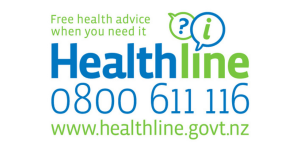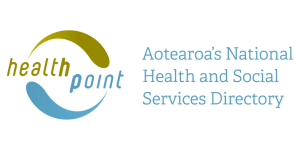IMPORTANT: Senior doctors and dentists at Health NZ public hospitals plan to strike for 48 hours on Tuesday 23 and Wednesday 24 September. Emergency departments will treat emergencies only. GPs, urgent care and other community providers will operate as normal.
Opioids in palliative care
Key points about opioid medicines in palliative care
- Opioid medicines are pain relievers, which are often used to treat pain caused by cancer.
- In Aotearoa New Zealand, about 2 out of 3 adults with terminal cancer will need an opioid.
- They include medicines such as morphine and oxycodone.

Not everyone with a terminal illness has pain. However, it's often people’s biggest fear and for some people it can be distressing. Pain can also impact on your quality of life – it can wear you down, make you irritable, make it hard to sleep, reduce your appetite, and make it difficult to be active and enjoy life. Everyone experiences pain differently, so the way you experience pain will be unique to you.
Opioid painkillers such as morphine and oxycodone are often used to relieve moderate to severe pain in palliative care. They may be used with other pain relief medicines such as paracetamol or NSAIDs (eg, ibuprofen).
In Aotearoa New Zealand, about 2 out of 3 adults with terminal cancer will need an opioid. Opioids are also used for other terminal illnesses including heart failure, kidney and liver disease, and neurodegenerative conditions. The use of opioids in palliative care doesn’t reduce the time to death.
Read more about palliative care and managing common symptoms.
Opioid painkillers are only available on a prescription and must be prescribed by a doctor, or nurse prescriber if it's in their scope of practice. They're used to help relieve pain and improve your quality of life.
In Aotearoa New Zealand opioids are generally available in 2 forms:
- short-acting (liquid or tablets) to relieve pain quickly, or
- slow-release (tablets or capsules) that you take 1 or 2 times a day to give stable pain relief throughout the day.
When you first start taking opioids you may be prescribed the short-acting liquid or tablets to find out how much of the opioid medicine you need to manage your pain.
After this, it’s common to be prescribed both forms of opioids. The slow-release tablets or capsules are taken regularly every day.
The immediate-release tablets or liquid is a lower dose that can be used, if and when required, for any sudden increase in pain – this is also commonly called ‘break-through’ pain. If you have to use your breakthrough pain medicine more than twice a week, talk to your healthcare provider about reviewing your pain management.
When choosing an opioid to manage your pain, your healthcare provider may discuss the following things with you.
- Choice of opioid: Morphine is the most commonly used opioid for severe pain. Other opioids include oxycodone, fentanyl and methadone.
- Timing of your doses: It's important to take your opioid pain relievers at the times prescribed (or as close as possible to those times) to get the most benefit from them. For example, delaying an opioid medicine that takes time to start working may result in you experiencing pain that could have been avoided.
- Swallowing difficulties: If you're having trouble swallowing tablets or capsules, you may be prescribed a liquid or a patch to put on your skin. Remember, not all tablets can be crushed or cut – ask your prescriber or pharmacist to check. Read more about difficulty swallowing medicines.
- Syringe drivers: If you can't take medicines such as tablets, capsules or liquids by mouth, a syringe driver may be used. A syringe driver is a small, portable, battery-operated pump used to inject medicines under the skin. Read more about syringe drivers.
- Breathing difficulties: Appropriate doses of opioids shouldn't cause breathing difficulties (also called respiratory depression).
- Side effects: All opioids can cause side effects such as constipation, nausea (feeling sick), dizziness and sleepiness. Constipation is common with all opioids so you’ll also be prescribed a laxative to take regularly. You may also be prescribed medicine for nausea to take just when you need it. Opioids can affect your driving. Don’t drive or if you have to, check if you have any symptoms before getting into your vehicle. Read more about driving and medicines.
- Addiction: Opioid addiction is uncommon in people with pain caused by a terminal illness.
- Tolerance: Opioids do become less effective over time because your body becomes used to the medicine. This is called ‘tolerance’. If your medicine isn't working as well as it used to, tell your doctor so they can review your dose, prescribe a different medicine, choose a different form, or prescribe a combination of medicines.
- Pain control plan: Your pain is unique to you. It's important to discuss your pain management options with your healthcare provider and develop a plan for how to best manage your pain. Having pain doesn’t always mean that your pain plan isn't working. It may mean that your medicines need to be reviewed. For examples of pain plans see pain management plan(external link) or developing a pain control plan(external link) from the American Cancer Society. A pain diary(external link) can be useful to document your pain levels.
The following links have more information on the use of opioids in palliative care. Be aware that websites from other countries may have information that differs from New Zealand recommendations.
Opioid medicines for short-term pain factsheet [PDF, 105 KB] Healthify He Puna Waiora, NZ English [PDF, 105 KB], te reo Māori [PDF, 126 KB]
Understanding morphine and other opioid medicine [PDF, 2.6 MB] Palliative Outcome Initiative, NZ
Use of strong opioids in palliative care(external link) NHS Trust, UK
Brochures
Understanding morphine and other opioid medicines Palliative Outcome Initiative English, Korean, Samoan, Simplified Chinese, Tongan
Facts about morphine and other opioid medicines for pain in palliative care [PDF, 1.6 MB] Palliative Care Australia
Morphine(external link) Mary Potter Hospice, NZ, 2018 English(external link), Cook Islands Māori(external link), Samoan(external link), Tongan(external link), Tokelauan(external link)
5 questions to ask about your medications(external link) Health Quality and Safety Commission, NZ, 2019 English(external link), te reo Māori(external link)
References
- Opioid analgesics(external link) New Zealand Formulary
- Strong opioids for pain management in adults in palliative care(external link) BPAC, NZ, 2012
- The Palliative Care Handbook(external link) NZ, 2019
- Prescribing opioids B-QuiCK summary(external link) BPAC, NZ, 2022
Brochures
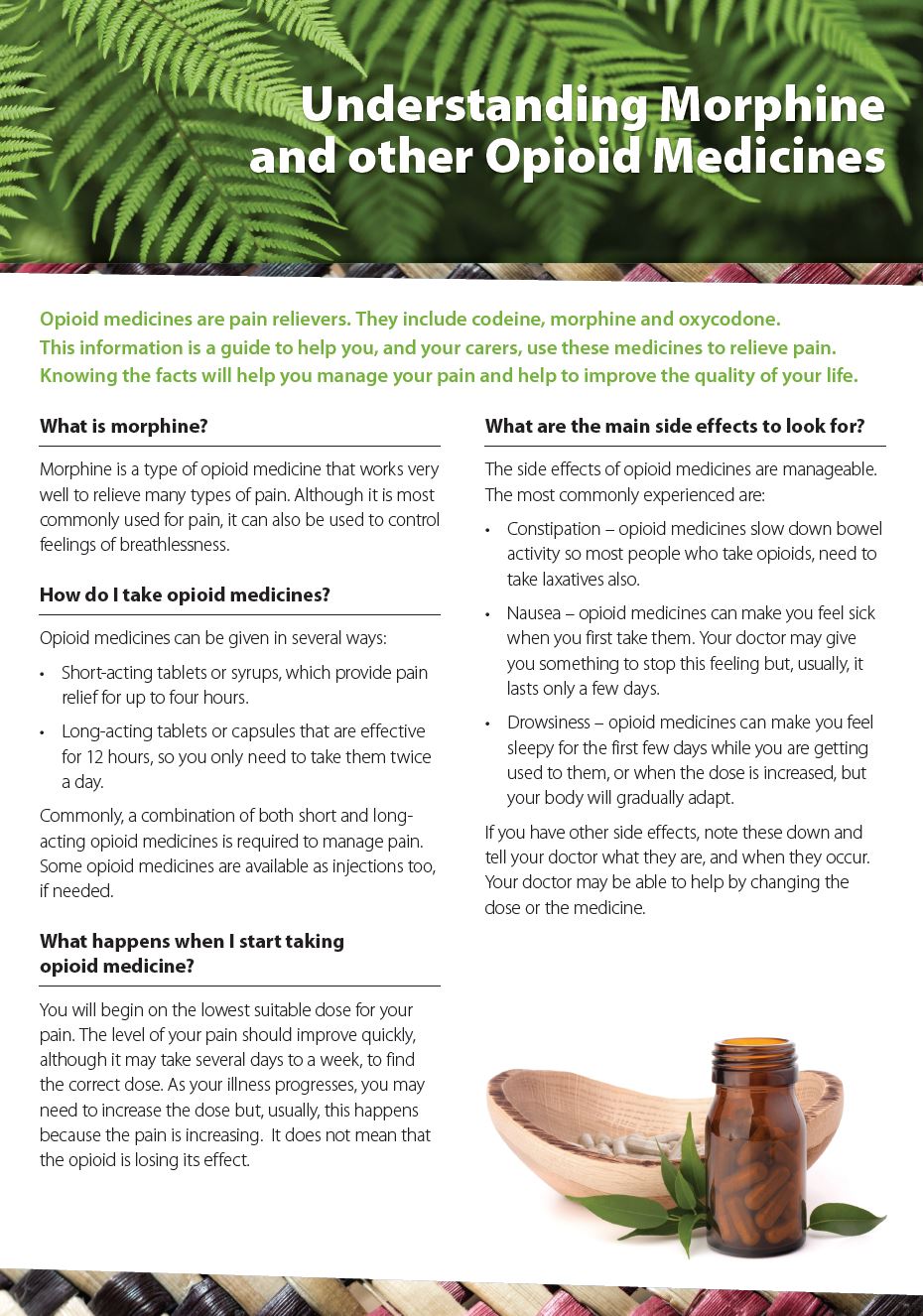
Palliative Outcome Initiative, NZ
English, Korean, Samoan, Simplified Chinese, Tongan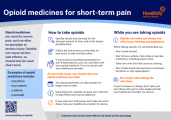
Opioid medicines for short-term pain factsheet
Healthify He Puna Waiora, NZ, 2023
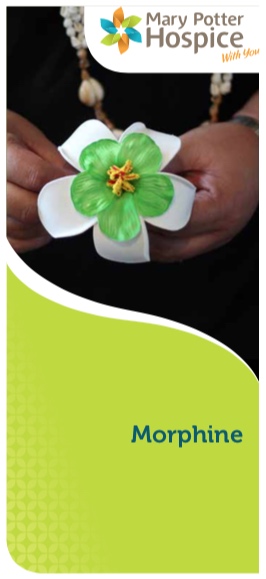
Mary Potter Hospice, NZ, 2018
English, Cook Islands Māori, Samoan, Tongan, TokelauanCredits: Healthify editorial team. Healthify is brought to you by Health Navigator Charitable Trust.
Reviewed by: Stephanie Yee, Pharmacist, Auckland
Last reviewed:


